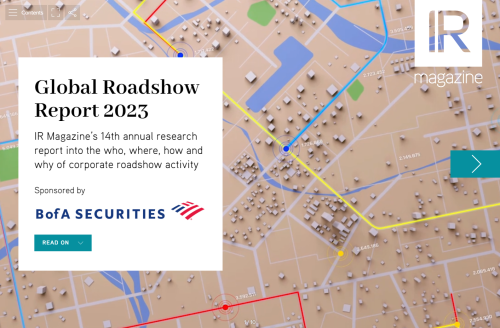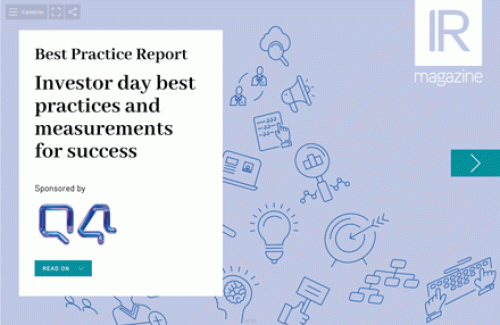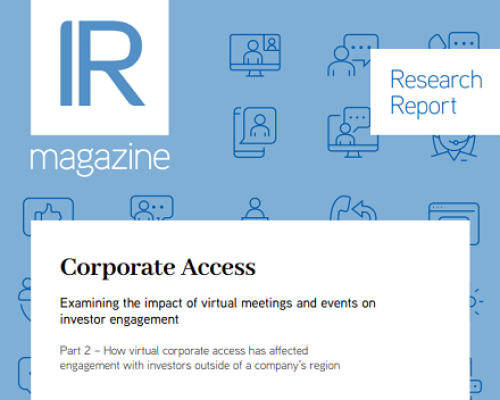Almost a decade has passed since Clare Harrison wrote the cover story for the July 2009 issue of IR Magazine. Titled On the road again, she looked at the evolution of the corporate access team – a change we continue to watch today.
|
IR Magazine July 2009: On the road again |
One area Harrison focused on was broker satisfaction. Speaking to Gunhild Grieve from RWE, Harrison found that IROs were increasingly taking control of the roadshow schedule as a result of low satisfaction. ‘We have had one bad experience, so now we always tell the brokers exactly who we want to see,’ Grieve explained at the time. ‘They can add suggestions but only once our target investors have been prioritized.’
And while Harrison noted a shift away from schedules packed with high-paying hedge funds as both the number of funds and their spending power dwindled, that didn’t necessarily mean companies were less willing to meet with them.
‘We are often trying to get feedback from brokers to see whether we should change our approach, and we always try to keep in touch with the hedge fund community,’ Grieve explained. ‘Hedge funds can be opinion leaders in the market, so you have to continue talking to brokers because they get a lot of insight, especially from players such as these.’
Since then, a number of institutions have come out with ‘no feedback’ policies (as far as brokers are concerned) – a hole the new breed of corporate access platforms have attempted to fill. But even in 2009, Michael Sullivan, corporate vice president of investor relations at Applied Materials, pointed to this growing trend.
‘The trend, especially in Frankfurt and Boston, is for investors to request a no-broker meeting,’ said Sullivan at the time. ‘More and more, certain institutions will adopt that policy if they want to keep their strategy close to their chest, for example.’
A third area of focus for Harrison was investor events, which were also feeling the effects of the credit crunch. ‘In addition to the staff changes, there have been implications for the nature of the events put on for companies and their investors. Low-key conferences and so-called reverse roadshows – where a single investor meets a series of companies – are in vogue, while the larger and flashier investment conferences of old take a back seat,’ she wrote.
‘There has definitely been a trend of cutting back on the large conferences,’ added Ulrike Zeilberger, then a managing director with UBS, now with IBM. ‘They have been either completely cancelled or scaled down. What you are seeing is an increased number of smaller, more targeted one-on-ones.’
The evolution continues
All the trends noted in 2009 as a result of the financial crisis continue to be talked about in the conversation around Mifid II: the sell side is shrinking, coverage is expected to fall (even if we continue to hear that it’s still ‘business as usual’) and IROs are expected to be taking on a lot more of the targeting and corporate access work performed by brokers in the past.
Nick Arbuthnott, former managing director of European research at Ipreo, pointed out at last year’s Global IR Forum in Paris that the slimming down of the sell side is part of a long-term trend – something Harrison’s 2009 cover story also serves to remind us.
But using information from the World Bank, IR Magazine and its own data, Ipreo predicts a rise in demand for events heading into 2020, with access to management becoming increasingly important for many investors – especially at small and mid-cap companies, where management might be less well known and where there’s a perception that there’s less publicly available information out there.
At the same time, Ipreo forecasts the number of meetings facilitated by the sell side to fall from around 85 percent in 2016 to less than 30 percent in 2020 as a result of Mifid II.
At the IR Magazine Think Tank – Europe 2018 (when Mifid II had been in force for more than six months), IROs were already beginning to notice a greater burden of direct contact from the buy side and the occasional hole in the roadshow schedule. But while there are expectations of extra workload, a number of people see a positive in the changes being brought about by the mammoth regulation. They predict that in a survival of the fittest situation in relation to research, companies will eventually find themselves with better quality coverage and higher levels of satisfaction. The evolution of the sell side, it seems, is not quite over.
As IR Magazine builds up to its 30th anniversary issue – the upcoming winter 2018 issue, which will be the 279th edition of the industry’s flagship magazine – we’ll be posting more throwbacks to old covers, revisiting some of the hot topics from the past 30 years of investor relations and hearing from some of the industry titans.
You can look back over old covers and keep track of all things 30th anniversary at our dedicated hub.











